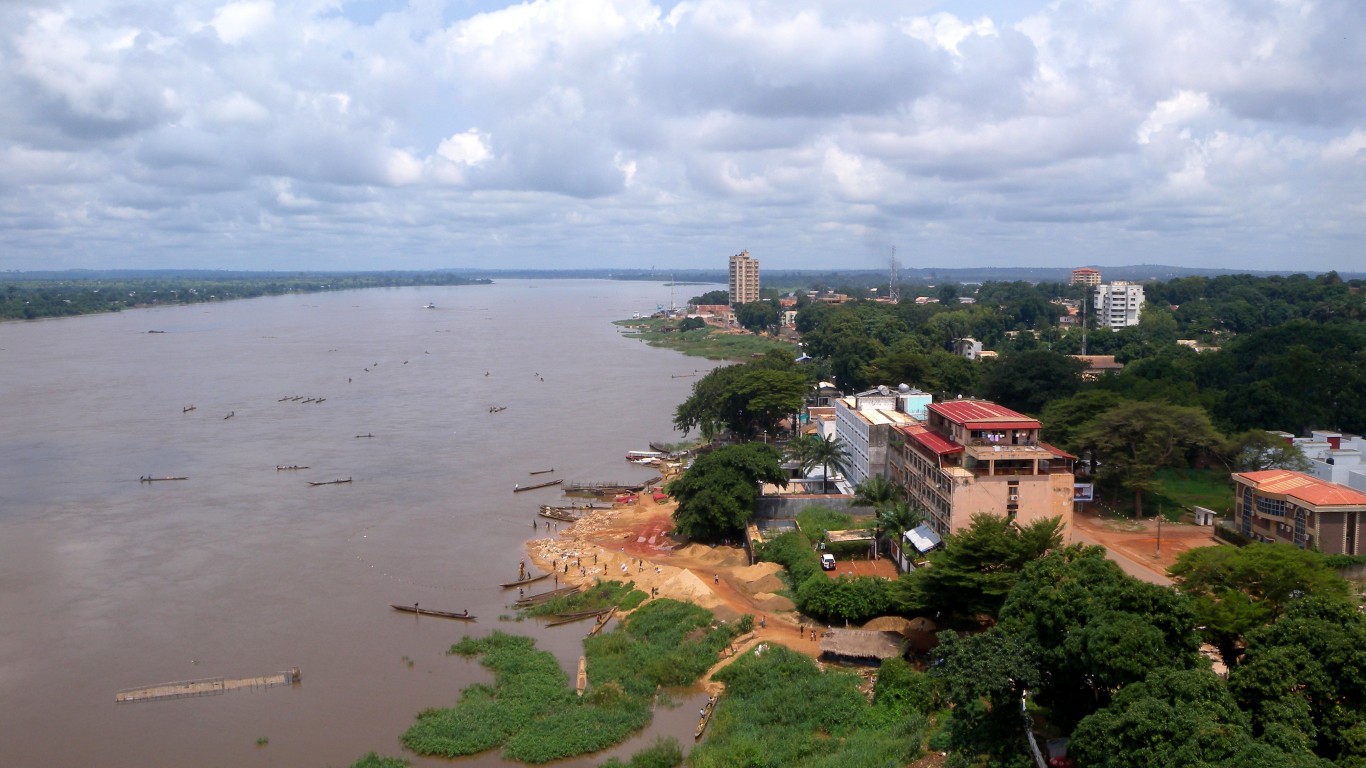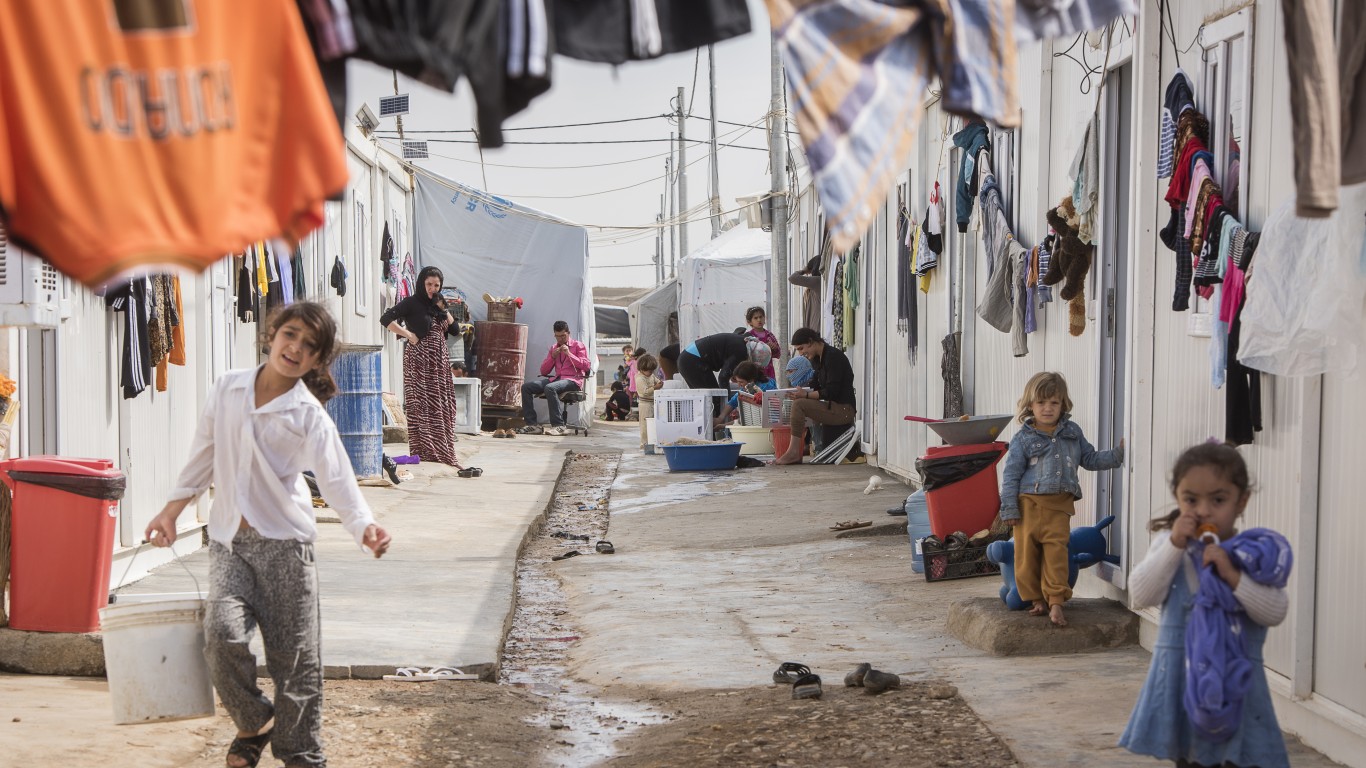
The world’s population continues to grow and stands at 7.93 billion people as of March 21. The annual number of births outstrips the yearly death total by almost 18 million people.
The population on the continents of Africa and Asia is growing the fastest. But even in those areas, there are nations whose populations are declining.
To determine the countries that will shrink the most in the 21st century, 24/7 Wall St. reviewed data on population projections from the U.S. Census Bureau’s International Programs Center. Countries were ranked based on the percentage change in projected population from 2022 to 2100.
A shrinking and aging demographic has dire consequences for a nation, straining healthcare and social-support systems, and damaging its competitiveness.
Every country on the list has a projected population decline of at least 33% by 2100. Only eight nations on the list have a crude birth rate of more than 10 people per 1,000.
Of the 15 European nations on the list, 14 of them are either former republics of the Soviet Union, or countries that comprised the former Soviet bloc before the Soviet Union collapsed in 1991. Many young people from eastern Europe have fled to western Europe and beyond for better economic opportunities. Estonia, one of the Baltic nations on the list and formerly under the thumb of the Soviet Union, is the only country on the list with net migration of more than 1.0 per 1,000 residents.
Despite the fact that they have some of the world’s largest economies, the Asian nations of China, South Korea, Taiwan, and Japan are all losing population. China, still reeling from the consequences from its disastrous decades-long one-child policy, may be overtaken by India within the next three years, according to some estimates. Japan’s population slide is tied to unfavorable demographics. A declining birth rate and the longevity of its elderly have made the country the oldest in the world, with 35.9 million people, or 28% of the population, 65 years old or older.
Even though Caribbean islands like Dominica and St. Lucia, and Pacific locations such as the Cook Islands and Federated States of Micronesia, might be exotic getaways, they are all suffering population declines.
Click here to see the countries on track to shrink the most this century
Click here to read our detailed methodology

25. Cuba
> Projected decline, 2022 to 2100: -33.4% (-3.7 million people)
> Current population: 11.0 million
> Crude birth rate: 10.0 per 1,000 people
> Annual net migration: -1.3 per 1,000 residents
[in-text-ad]

24. China
> Projected decline, 2022 to 2100: -33.8% (-477.4 million people)
> Current population: 1.4 billion
> Crude birth rate: 10.5 per 1,000 people
> Annual net migration: -0.3 per 1,000 residents

23. Dominica
> Projected decline, 2022 to 2100: -35.3% (-26,311 people)
> Current population: 74,629
> Crude birth rate: N/A
> Annual net migration: N/A

22. Mauritius
> Projected decline, 2022 to 2100: -36.2% (-472,998 people)
> Current population: 1.3 million
> Crude birth rate: 10.2 per 1,000 people
> Annual net migration: N/A
[in-text-ad-2]

21. Croatia
> Projected decline, 2022 to 2100: -36.4% (-1.5 million people)
> Current population: 4.2 million
> Crude birth rate: 8.9 per 1,000 people
> Annual net migration: -1.9 per 1,000 residents

20. South Korea
> Projected decline, 2022 to 2100: -37.2% (-19.3 million people)
> Current population: 51.8 million
> Crude birth rate: 5.9 per 1,000 people
> Annual net migration: +0.2 per 1,000 residents
[in-text-ad]

19. Romania
> Projected decline, 2022 to 2100: -38.1% (-7.0 million people)
> Current population: 18.5 million
> Crude birth rate: 9.6 per 1,000 people
> Annual net migration: -3.7 per 1,000 residents

18. Ukraine
> Projected decline, 2022 to 2100: -38.4% (-16.7 million people)
> Current population: 43.5 million
> Crude birth rate: 8.1 per 1,000 people
> Annual net migration: +0.2 per 1,000 residents

17. Montenegro
> Projected decline, 2022 to 2100: -38.6% (-233,684 people)
> Current population: 604,966
> Crude birth rate: 11.7 per 1,000 people
> Annual net migration: -0.8 per 1,000 residents
[in-text-ad-2]

16. Andorra
> Projected decline, 2022 to 2100: -40.1% (-34,317 people)
> Current population: 85,560
> Crude birth rate: 7.0 per 1,000 people
> Annual net migration: N/A

15. Serbia
> Projected decline, 2022 to 2100: -40.2% (-2.7 million people)
> Current population: 6.7 million
> Crude birth rate: 9.3 per 1,000 people
> Annual net migration: +0.6 per 1,000 residents
[in-text-ad]

14. Taiwan
> Projected decline, 2022 to 2100: -40.5% (-9.5 million people)
> Current population: 23.6 million
> Crude birth rate: N/A
> Annual net migration: N/A

13. Poland
> Projected decline, 2022 to 2100: -40.5% (-15.4 million people)
> Current population: 38.1 million
> Crude birth rate: 9.9 per 1,000 people
> Annual net migration: -0.8 per 1,000 residents

12. Albania
> Projected decline, 2022 to 2100: -40.8% (-1.3 million people)
> Current population: 3.1 million
> Crude birth rate: 11.6 per 1,000 people
> Annual net migration: -4.9 per 1,000 residents
[in-text-ad-2]

11. Japan
> Projected decline, 2022 to 2100: -41.3% (-51.3 million people)
> Current population: 124.2 million
> Crude birth rate: 7.0 per 1,000 people
> Annual net migration: +0.6 per 1,000 residents

10. Bulgaria
> Projected decline, 2022 to 2100: -42.0% (-2.9 million people)
> Current population: 6.9 million
> Crude birth rate: 8.8 per 1,000 people
> Annual net migration: -0.7 per 1,000 residents
[in-text-ad]

9. Saint Lucia
> Projected decline, 2022 to 2100: -43.3% (-72,342 people)
> Current population: 167,122
> Crude birth rate: 11.8 per 1,000 people
> Annual net migration: N/A

8. Lithuania
> Projected decline, 2022 to 2100: -43.9% (-1.2 million people)
> Current population: 2.7 million
> Crude birth rate: 9.8 per 1,000 people
> Annual net migration: -11.3 per 1,000 residents

7. Bosnia and Herzegovina
> Projected decline, 2022 to 2100: -44.4% (-1.7 million people)
> Current population: 3.8 million
> Crude birth rate: 7.9 per 1,000 people
> Annual net migration: -6.3 per 1,000 residents
[in-text-ad-2]

6. Cook Islands
> Projected decline, 2022 to 2100: -48.3% (-3,926 people)
> Current population: 8,128
> Crude birth rate: N/A
> Annual net migration: N/A

5. Estonia
> Projected decline, 2022 to 2100: -48.3% (-585,715 people)
> Current population: 1.2 million
> Crude birth rate: 10.6 per 1,000 people
> Annual net migration: +3.0 per 1,000 residents
[in-text-ad]

4. Federated States of Micronesia
> Projected decline, 2022 to 2100: -51.4% (-51,875 people)
> Current population: 101,009
> Crude birth rate: 22.7 per 1,000 people
> Annual net migration: -5.5 per 1,000 residents

3. Moldova
> Projected decline, 2022 to 2100: -55.0% (-1.8 million people)
> Current population: 3.3 million
> Crude birth rate: 9.9 per 1,000 people
> Annual net migration: -0.5 per 1,000 residents

2. Latvia
> Projected decline, 2022 to 2100: -55.0% (-1.0 million people)
> Current population: 1.8 million
> Crude birth rate: 9.8 per 1,000 people
> Annual net migration: -7.5 per 1,000 residents
[in-text-ad-2]

1. Armenia
> Projected decline, 2022 to 2100: -56.9% (-1.7 million people)
> Current population: 3.0 million
> Crude birth rate: 13.6 per 1,000 people
> Annual net migration: -1.7 per 1,000 residents
Methodology
To determine the countries that will shrink the most in the 21st century, 24/7 Wall St. reviewed data on population projections from the U.S. Census Bureau’s International Programs Center. Countries were ranked based on the percentage change in projected population from 2022 to 2100. Supplemental data on the crude birth rate is from the World Bank and is for the year 2019. Data on net migration for the period 2013 to 2017 came from the World Bank and was adjusted for population using data from the World Bank.
Cash Back Credit Cards Have Never Been This Good
Credit card companies are at war, handing out free rewards and benefits to win the best customers. A good cash back card can be worth thousands of dollars a year in free money, not to mention other perks like travel, insurance, and access to fancy lounges. See our top picks for the best credit cards today. You won’t want to miss some of these offers.
Flywheel Publishing has partnered with CardRatings for our coverage of credit card products. Flywheel Publishing and CardRatings may receive a commission from card issuers.
Thank you for reading! Have some feedback for us?
Contact the 24/7 Wall St. editorial team.
 24/7 Wall St.
24/7 Wall St. 24/7 Wall St.
24/7 Wall St. 24/7 Wall St.
24/7 Wall St.
